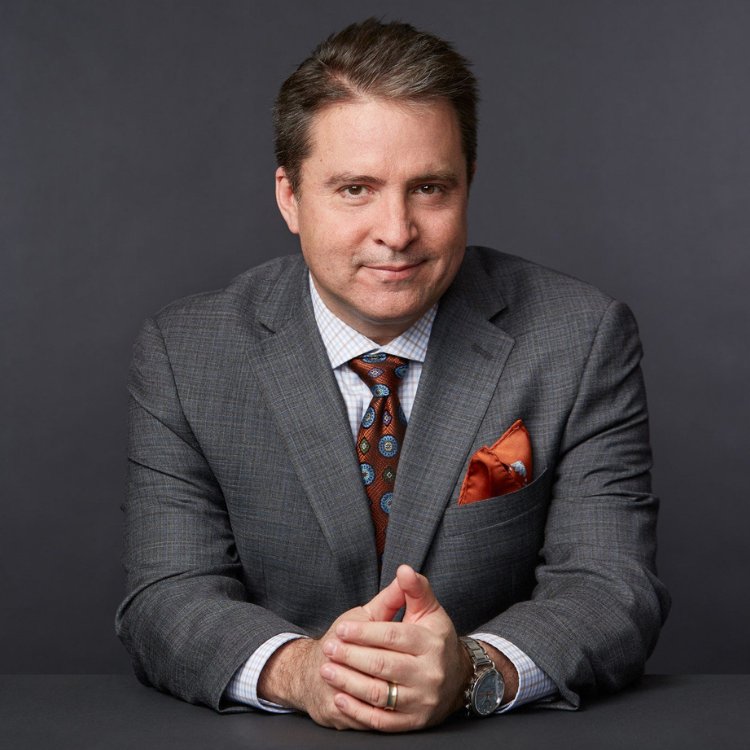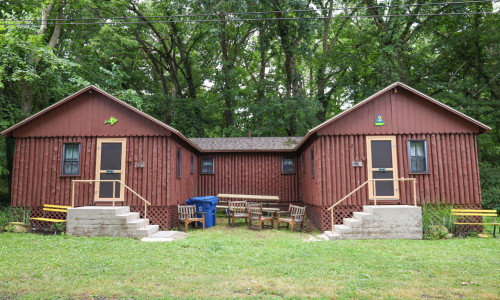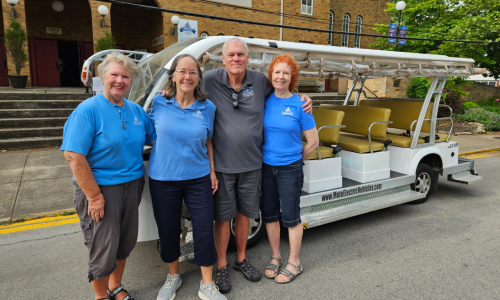By Kevin Greer
Lakeside Communications Manager

Robert Jones has never been to Lakeside, but he knows how to spend his time when he arrives.
“I have no plans,” Jones said. “I’m mostly hoping to just unwind.”
Between that, the President and founder of the Public Religion Research Institute (PRRI) and award-winning author will be the Keynote Speaker in Hoover Auditorium at 7:30 p.m. Thursday, June 20.
Jones wrote the New York Times bestseller The Hidden Roots of White Supremacy and the Path to a Shared American Future (published in 2023), as well as White Too Long: The Legacy of White Supremacy in American Christianity, which won a 2021 American Book Award. He is the author of The End of White Christian America, which won the 2019 Grawemeyer Award in Religion. Jones will also have a book signing while in Lakeside. His books are available at The Fine Print bookstore.
Jones regularly writes on politics, culture and religion for The Atlantic, Time, Religion News Service and other outlets. He is frequently featured in major national media, such as CNN, MSNBC, NPR, The New York Times, The Washington Post and others.
The Lakesider newspaper had the opportunity to talk with Jones via Zoom. The interview has been edited for clarity and space restrictions.
What is your keynote about?
Jones: I’ll be talking about my latest book, Hidden Roots of White Supremacy and the Path to a Shared American Future, and thinking about this long history of the entanglement of white supremacy and Christianity in America and how that is still with us today.
How would you describe your writing style: Are you controversial, trying to send a message, a combination of those or is it something else altogether?
Jones: I’m a sociologist and religion scholar by training, so that’s the world I come from. I would say the more I’ve written, the more this style has gone narrative. I’m trying to tell stories that help us understand not only our past, but how it has shaped the present, then how that might help us live into a better future. I see the writing is largely in service of democracy and living into the better promises of a pluralistic democracy in the country and try to hook the ways that religion has both been in the way of that work and has helped it along.
What is your latest book about?
Jones: This last book is more history than I’ve written before. It covers all the way back to the 15th century. I think what it is trying to find is the tap root or the most proximate cause of white supremacy. How does this kind of commitment to white supremacy get injected into the DNA of American culture? In my last book, I traced that back into the 19th century, to the Civil War and fights over slavery. In this book, I wanted to go back a little further and just see how does it get here, how does it land on the shores of the country and what does that look like? I traced it back to this thing called the doctrine of discovery, which was the set of 15th century Catholic doctrines that really underwrote the entire colonial project. Essentially, it boiled down to giving European Christians, specifically, the kind of blessing of the church and a kind of moral mandate to go and occupy these newly ‘undiscovered’ lands from the European perspective. Also to occupy and control them in the name of the church and the European powers.
Minnesota, Oklahoma and Mississippi were case studies in the book. Was your point that racism wasn’t just in the south?
Jones: I think that’s right. I write about this entanglement and this idea that European civilization and Christianity were superior to everything else on the planet. That was the worldview that landed on the shores, and not just in the Deep South. I could have written 50 chapters, one for every state. If I told you that story of the lynching of three Black men that happened in Duluth, Minnesota, and I didn’t tell you where it was from, you would assume it happened in Georgia, Alabama or Mississippi. It happened in this northern, very white city. In Oklahoma, it was more of a western frontier setting. I wanted to tie together not just a Black-white dynamic, which is what you get if you really think about the 19th century mostly, but if you go further back, you realized that this same worldview was the same one governing the interactions of Europeans with indigenous people as well. By including Oklahoma, it helped me stitch together that longer story that had both European interaction with indigenous folks and European interaction with enslaved Africans as well.
White supremacy is a hot topic. How dangerous is it?
Jones: When you say that word in public, what people tend to think of is the Ku Klux Klan. That’s obviously one aspect of how white supremacy is most visible in the country. If we only think about it that way, it does a disservice because it puts it pretty far away from most of us. We tend to think about that as something that happened in the first half of the 20th century, but not now. If we just flipped the words around, it’s the supremacy of white people to other races. Then you realize that’s much closer to home than most of us would like to admit. You can’t go to any town in the country where there’s not a history of the public parks, pools, schools, libraries and accommodations of all kinds being reserved for whites. That was all from this idea that the best things that the city had to offer went first to white folks, and second to everyone else. I’m trying to bring that idea a little closer and make it not only the most violent, most extreme things, but a worldview that’s been snuggled up closer to us than many of us would like to think.
Are there similarities with radical Islam and Christian nationalism?
Jones: I would say there are certainly religious nationalisms around the world that we see not only in majority Muslim states, but Hindu nationalism in India, for example, is cut from the same cloth. It’s a claim that the people of one religion are first class citizens in the state and everyone else is second class citizens with second class rights. In the U.S., it tends to be whatever is the majority religion is the one that ends up making those claims, and that’s Christianity. I think there are certainly cousins of this across the globe in other religions where it tends to be the majority religion making claims against religious minorities in the country, that they are the true Americans, Hindus, Indians, Saudis or whatever nationality, against everyone else. In the U.S. context, it’s not just religious nationalism, but it’s Christian, because of our history and the dominance of Christianity here. It is also ethnic, so it’s not just religious. Usually when I talk about this, it’s white Christian nationalism, because it does have this European heritage to it. The thing that people are often defending is not just a religious outlook. That really does mean a kind of European Christian, usually Protestant version of that. We even have an acronym, WASP, White Anglo Saxon Protestant, that describes the long history of the dominant, not only religion, but social class in the country. I think that’s the form taken in the U.S.
Are some churches becoming too political?
Jones: There’s partisanship and right now currently under IRS law, organizations that are organized as churches and receive tax benefits from that status are prohibited from endorsing elected officials. They’re not in any way hindered from speaking out on issues that they think are important from their religious background. That’s something that they’ve always been allowed and continued to be allowed to do. Churches police themselves, I think, on which issues from their particular belief system they felt like the institution should take a stand on. Americans had separation of church and state but not separation of religion and politics.
Do you feel racism is improving in this country, or is it getting worse?
Jones: It’s hard to say. One of the things that I think is undoubtedly true is that it’s more out in the open today. About 20 years ago, you’ll hear people say something like, ‘Oh, that’s a racist dog whistle.’ If somebody is talking about school desegregation, they would make strong arguments against busing, but it was really an argument about not wanting to mix the races. I also think it’s more sharply divisive today because of the changing demographics in the country. I mentioned that WASP dominant sense of things and that white Christians are no longer a majority in the country, and that’s only happened in the last 20 years. If you want to know why are we are experiencing some of this, I think it’s because we’ve gone from being a demographically-speaking majority white Christian country to one that’s no longer a majority white Christian country. That’s a new experience to not be in the majority, so it’s quite an adjustment. I think some of the tensions and backlash that we’re experiencing have been because of that shift in the culture that’s made these debates more visceral and more polarizing in the last 20 years.
Years ago, it seems like racism was just a Black and white thing, but it’s not anymore.
Jones: I think the other place I’d point to in the U.S. context is immigration. It has become a huge divisive point in the country and in a way that it wasn’t there just 20 years ago. Not that it’s ever been a simple issue, but in the era of George W. Bush, there was quite a consensus around thinking about some ways we could handle dealing fairly with undocumented people. Those coalitions have just fallen apart. We’re hearing more of a demonization of immigrants that has a racial hue to it. The immigrants who are getting criticized are largely from Mexico. What the bigger picture points today is our political fault lines are less about issues, and more about identity. Who is properly in America and who is this country for? Those questions are where I think the bigger fault lines are today.
You talk and write about politics, culture and religion. Do you have a favorite?
Jones: You don’t want to invite me to a cocktail party because I’ll be the person causing all the problems. I’ve always been interested in all three and I was torn between going to seminary and law school when I was in my 20s. Through this lens of sociology and history, I’ve been fascinated with the ways that history shapes beliefs, and then beliefs shape politics. The vectors go in every direction because political commitments then shape beliefs and history going forward as well. I think that interplay between these forces has always been something that’s fascinated me and I’ve been lucky enough to find a vocation where I have been given the tools from academic training and sociology to see these interactions between these three forces.
What is PRRI?
Jones: We are a nonprofit, nonpartisan organization based in Washington, D.C., that conducts research at that intersection of religion, culture and politics. We interview somewhere between 60,000-80,000 people a year. Our mission is to provide the public and journalists with the best snapshots of how Americans beliefs and values shape their political beliefs and behaviors. We have about 3,500 media outlets that rely on our data every year, ranging from national to local. We help put out the best independent research that we can.
Why are so many people leaving churches?
Jones: There’s no doubt there is a decline in formal religiosity however you measure it. When I say formal religiosity, I mean people who want to claim a membership in a particular religious tradition. On the other end of that spectrum, the number of people claiming no religious affiliation has been going up. If we just go back to the 90s, only single digits of Americans claimed no religious affiliation. That number today is pushing 30%, and if you look at young people, it’s about four in 10. PRRI did a survey focused on people who were raised religious and then left. They gave a range of beliefs, some of them were fairly mundane like, ‘I just stopped believing the tenets of the religion.’ We noticed about a third of them told us that it was negative treatment or negative teachings of LGBTQ people. It goes up to about half of young people saying that. Among Catholics, many named the clergy abuse scandals. Other things we know is the church has become too partisan and not just political, backing one particular political party over others. I think there’s this general sense that churchgoing and being perceived as a kind of upstanding citizen aren’t necessarily tied together.
How do churches get them back in?
Jones: There’s not a lot of hopeful data there. We did ask people who were raised religious and left, ‘Are you looking for a tradition that would be a better fit for you?’ Only about one in 10 said ‘Yes,’ to that question. The idea that people are active seekers and they’re just lacking an opportunity isn’t quite right. I think about nine and 10 say they’re perfectly content not being affiliated. We asked why they left, and many people cite that they want to be in a community of like-minded people. Also, people say they want to raise their kids in an environment where they would learn values, morality and those sorts of things. Those reasons are still there. For many of those who’ve left, it’s not strong enough for them to be actively looking for somewhere else to go.
What is the biggest challenge that churches face then right now?
Jones: Relevance. Church attendance ballooned right after World War II. There was a baby, church and financial booms. The current structures that we have were largely built and floated along on that current. There’s a way in which you can see that current is crested right and it’s receding. The question will be, ‘What does the next iteration look like?’ We need to find more flexible ways to involve people and it’s really about providing meaning and community and getting back to those things.
Have you ever thought about running for political office?
Jones: I don’t think so. I like my role as an observer, analyst and writer. I like being in places like Lakeside and talking about it.




